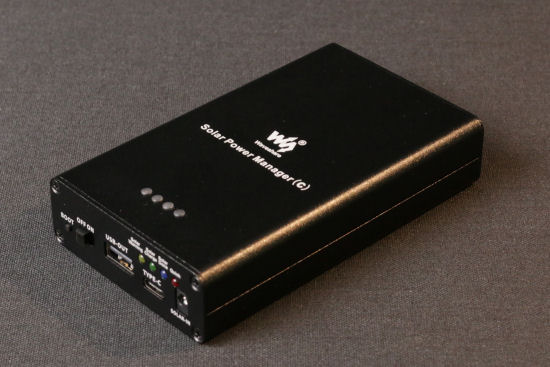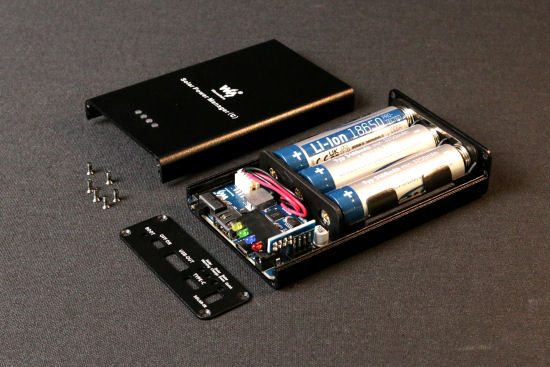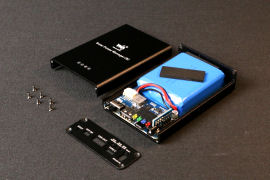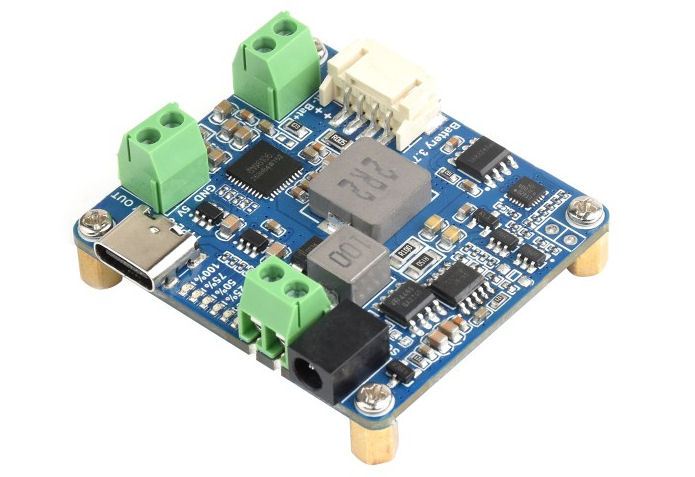![]() This week, we're continuing our quest for the ideal USB battery to power systems built with Yoctopuce modules, and we've found a model sold by Waveshare that seems worth a look.
This week, we're continuing our quest for the ideal USB battery to power systems built with Yoctopuce modules, and we've found a model sold by Waveshare that seems worth a look.
As a reminder, the problem with most modern USB batteries is that, being essentially designed to charge devices, they completely shut down as soon as they realize that little or no current is being drawn from their output. Obviously, this behavior interferes with the sleep function of WiFi and GSM hubs.
Waveshare Solar Power Manager (variant C)
The Solar Power Manager (C) battery sold by Waveshare takes the form of a metal case measuring 11x7x2.5cm and weighing around 170g when empty. On one side, there's an ON/OFF switch, a USB-A output, and a USB-C socket for powering a device or charging the battery. The USB-C socket is compatible with chargers featuring the Power delivery function, enabling fast charging. Finally, there's a connector for a solar panel, as this battery can be recharged from a solar panel providing it supplies between 6 and 24V.

Solar power manager (C) from Waveshare
The metal case is assembled with screws and is easy to dismantle. Inside, you'll find the electronics, of course, but also a battery holder for three 18650 li-ion batteries (not supplied). We chose to use 3 x 3400 mAh li-ion batteries, giving a total capacity of 3.7V*3.4Ah*3 = ~37Wh. The fact that the electronics are so easily accessible is a big advantage: should the need arise, it will be very easy to apply some conformal coating on the electronics to improve its resistance to humidity.

You can dismantel the case very easily
We ran the same experiment as last time, powering a Yocto-Meteo-V2 via YoctoHub-Wireless-n. The hub wakes up every 10 minutes, sends the Yocto-Meteo-measures to a VirtualHub for Web server and immediately goes back to sleep. In contrast to last time, the results are quite respectable: the experiment ran without interruption for 19.4 days before the battery decided to cut its USB output, but remained alive for a further four days before shutting down completely.
The battery lasted 19 days and 10 hours
The Yocto-Meteo and YoctoHub-Wireless-n together consume around 100mA at 5V, and the Hub stays on for around 10 seconds for each callback. A callback consumes around 10s*5v*0.1A/3600s = 1.4mWh. Over a period of 19.4 days, at a rate of 6 callbacks per hour, the Yoctopuce electronics consumed around 4Wh of the 37Wh available. Knowing that the 15µA sleep consumption of the YoctoHub-Wireless-n is negligible, we conclude that the battery's internal consumption is the main factor influencing the experiment's autonomy. We can even easily compute this consumption as (37-4)Wh / 19.4d / 24h / 5V = ~17mA, assuming that consumption once the USB output is switched off is negligible.
We checked that, after having been switched off due to a lack of power, the battery is capable of reactivating itself as soon as it is recharged with a solar panel or a USB charger. In other words, a solar installation based on this battery, which dies for lack of sufficient sunlight, should be able to resurrect itself as soon as the sun comes back out.
The fact that this battery works with standard-format rechargeable batteries can be interesting insofar as it enables a device based on this battery to be manufactured and shipped without rechargeable batteries anywhere in the world, without having to worry about legislation on the transport of lithium batteries. On arrival, the user will be able to purchase the batteries locally.
Sold for around $22, this battery seems very inexpensive, but beware: the cost of the three 18650 li-ion batteries quickly adds up.
Waveshare Solar power manager (variant B)
There is a variant B of the Solar Power Manager battery, which works with a pre-installed 10000mAh lithium-polymer battery. This 37Wh lipo battery consists of two cells wired in parallel. The casing is 11mm shorter than variant C, but remains strictly identical, for a total weight of around 290g.


The Solar Power Manager battery (B), the only differences being the battery and the length of the case.
However, when we tested this battery, we found that it systematically switched off a few seconds after the YoctoHub-Wireless-n went to sleep. In short, despite its identical appearance to variant (C), variant (B) is apparently unusable for our application. We've contacted WaveShare support to find out more.They belatedly replied that variants (B) and (C) work identically. After we proved to them that this wasn't the case, they finally admitted that there are in fact two versions of variant (B), one that switches off and a newer one that doesn't. Waveshare's support doesn't seem to know exactly when the change was introduced (2023 or 2024). Apparently the only way to tell them apart is to try.
Waveshare Solar power manager (variant D)
There's also a variant D of the Waveshare Solar Power Manager, an electronic board that we assume to be equivalent to those present in variants B and C, but equipped with screw terminal blocks. This bare version, equipped with mounting holes, could perhaps simplify integration into a project. We hadn't originally planned to test it, but given the difference in behavior between versions (B) and (C), we're going to order one to find out for sure.

The Solar Power Manager battery, variant D (source: waveshare)
Conclusion
The Solar Power Manager (B) is more or less useless for us, but the Solar Power Manager (C) variant is a pleasant surprise. We're not sure how this inexpensive batterie will perform on the long term, but it is an excellent candidates for powering a Yoctopuce experiment set up in the middle of nowhere. What's more, when powered by a modestly sized solar panel, it should be able to keep a not-too-greedy installation running indefinitely.
Edit: here are quick links to the whole series of articles about USB batteries: Part 1 - Part 2 - Part 3 - Part 4
(Edited on 16/09 avec Waveshare's answer).


